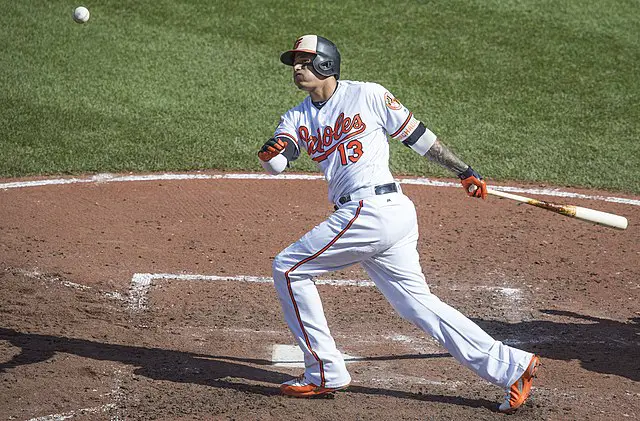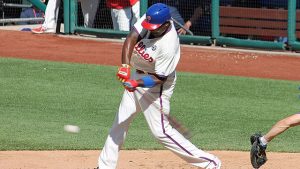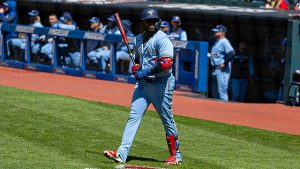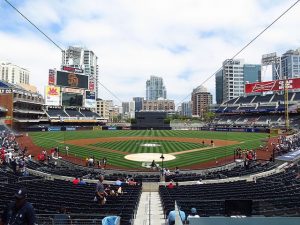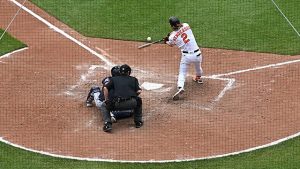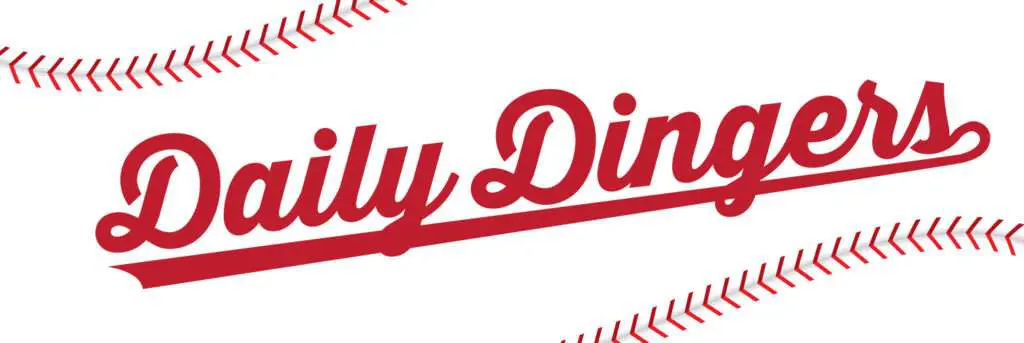Last Updated on March 11, 2024 by Matt Musico
If you’re wondering which sluggers are among the Orioles single season HR leaders at each position, then you’re in the right place. Below, we’ll be going through the most powerful seasons around the diamond in franchise history.
There are a number of ties, which is always interesting to look at. Outside of pitchers, each hitter needed to qualify for the batting title while also manning their respective positions for at least 75% of the time.
Once you’re done here, be sure to also check out the single-season and all-time home run leaderboards in Orioles history.
Want to see the Orioles slug dingers in person? Grab tickets from our friends at Vivid Seats. And before you get to the stadium, make sure you’re decked out in the right gear. Get official Orioles merch from the MLB Shop or a ‘Big Dinger Energy’ shirt from our apparel store.
Orioles Single Season HR Leaders
Catcher: Gus Triandos, 1958: 30 Home Runs
Gus Triandos made it to the big leagues with the New York Yankees. He didn’t do much in 20 games played from 1953-54, though. He landed with the Orioles in ’55, where the backstop would spend eight of his 13 MLB seasons. It was not only the majority of his tenure, but it was also the majority of his production.
The 1958 campaign was Triandos’ second of three straight All-Star Game selections. His 11th-place finish in American League MVP voting was also the highest of his career.
Triandos spent most of 1958 serving at Baltimore’s cleanup hitter. He racked up 318 plate appearances in that position, hitting 17 of his 30 home runs in the process. The “Golden Greek” didn’t produce a double-digit homer month during this career-best power surge, but he came close. June included his highest OPS (.887) of any month, along with the most homers (nine) and RBI (23).
Pitcher: Jack Harshman, 1958: 6 Home Runs
Jack Harshman and Triandos formed a pretty fearsome battery… at the plate. Harshman also put together a solid campaign on the mound, though.
His 236.1 innings was the second and final time he got over the 200-inning plateau. Harshman paired that output with a 12-15 record, a 2.89 ERA, and 1.18 WHIP. At the plate, the hurler knew how to slug home runs.
The southpaw was a career .179 hitter across 522 plate appearances. He collected just 76 total hits during his big-league career, and 21 of them sailed over a fence. So, just over one quarter of his career hits were home runs. It was an all-or-nothing situation, too — Harshman slugged just seven doubles and no other extra-base hits outside of those homers.
The six dingers he collected in 1958 was actually the second time he reached that number. He had previously done it in ’56 with the Chicago White Sox.
First Base: Chris Davis, 2013: 53 Home Runs
Before Chris Davis‘ production fell off the face of the Earth, he was one of the league’s most feared power hitters in Baltimore. His 53 home runs in 2013 were not just a career-high mark. This helped Davis lead the American League in homers that year, and it still stands as a single-season franchise record. His ascension in the homer department at the start of his career was quite astounding, too.
In his first four seasons, Davis slugged 44 homers in 1,082 plate appearances. His first full season with the Orioles was in 2012, which led to 33 dingers in 562 plate appearances. Then, of course, was this performance, which landed him third in AL MVP voting.
Davis hit at least nine homers in a month on four occasions in 2013. May and June was the most powerful two-month stretch. He combined to hit 22 homers during that time. While Davis cooled off over the final three months, his first three months were just unreal. Through his first 342 plate appearances, the first baseman slashed .332/.406/.728 with 31 home runs, 25 doubles, 80 RBI, and 60 runs scored.
Second Base: Jonathan Schoop, 2017: 32 Home Runs
https://www.youtube.com/watch?v=HAo-oKciVE0
Jonathan Schoop‘s MLB career is still going at the time of this original writing (prior to 2023 season). But unless something crazy happens, his power peak took place in Baltimore. He’s slugged 20-plus homers five times, with three coming consecutively from 2016-18. That 2017 campaign has stood out as his best in OPS (.841), homers (32), and RBI (105).
The right-handed hitter did take advantage of the hitter-friendly confines of Camden Yards. Of his 32 total homers, 18 came at home, where he posted an OPS about 100 points below his mark on the road (.891 vs. .792).
Schoop mostly did his damage with the home-run ball during the middle of games. Innings 1-3 and 7-9 included eight homers each, while innings 4-6 included 16 dingers from the second baseman.
Shortstop: Cal Ripken Jr. (1991) & Miguel Tejada (2004): 34 Home Runs
Cal Ripken Jr. is the Orioles’ all-time home run leader and the career leader for shortstops, so it would’ve been surprising if he didn’t make it here. Baseball’s iron man put together 10 straight years of 20-plus homers and 12 such performances overall. The 1991 season — an MVP campaign for the Hall of Famer — was the lone time he got above 30 dingers.
The month of July was the only time Ripken didn’t posting a batting average higher than .311 (it was .246). Over the first three months, he slashed .355/.413/.614 with 17 homers and 51 RBI.
After a successful stint with the Oakland Athletics that included winning the 2002 AL MVP Award, Miguel Tejada immediately made a good impression in Baltimore. The 2004 season was his first with the Orioles. In addition to tying Ripken for the franchise’s single-season shortstop record, he also led the league with 150 RBI while slashing .311/.360/.534.
He slugged exactly 17 homers at home and on the road in ’04. In the first three months, he hit more than five dingers just once (six in May). Over the final three months, Tejada hit more than five each time (seven in July, six in August, eight in September/October).
Third Base: Mark Reynolds (2011) & Manny Machado (2016): 37 Home Runs
This is not the first time we’re seeing Mark Reynolds here, folks. He’s also the single-season home run leader for DBacks third baseman. He posted a monthly OPS higher than .800 twice in 2011, and nobody would’ve thought he was on his way to setting a franchise record by the end of April.
Through Reynolds’ first 95 plate appearances, he was slashing .169/.253/.313 with two homers and 14 RBI. His power production obviously picked up, never hitting fewer than five in any of the remaining five months. This included a three-month stretch where he hit eight homers in each of June, July, and August.
Manny Machado experienced his power breakout with the Orioles in 2015. He posted career-high marks in OPS (.861), home runs (35), and RBI (86) while placing fourth in AL MVP voting. The third baseman followed that up by beating each of those numbers (.876, 37, 96) and placing fifth in MVP voting. Not a bad follow-up.
He performed best at the plate against power pitchers. In 244 plate appearances for this situation, Machado slashed .333/.396/.576 with eight homers and 24 RBI. His OPS continually dropped when he went from facing a power pitcher (.971) to an average power/finesse pitcher (.877) to a finesse pitcher (.802).
Orioles Single Season HR Leaders
Left Field: Ken Williams (1922) & Boog Powell (1964): 39 Home Runs
Ken Williams‘ 1922 season was in the middle of a powerful three-year stretch for the Orioles outfielder. In 1,975 plate appearances, Williams slashed .345/.427/.605 while averaging 31 homers, 121 RBI, and 116 runs scored. Obviously, his performance in ’22 was the best of all. His 39 homers led the league, as did his 155 RBI.
Williams’ homer production was evenly split between the first half (20) and second half (19), but he preferred to hit at home. That was evidenced by seeing that 32 of his homers and 102 of his RBI came in front of the home crowd. This performance included a .373/.438/.800 triple slash.
Boog Powell‘s 1964 production was the culmination of a quick ramp-up in his power progression. His first full season included 15 dingers in 124 games as a 20-year old. He followed that up with 25 in 140 games the next year before slugging 39 in ’64.
Boog went HAM after a rough start to the year, too. On the morning of May 1st that season, Powell owned a .452 OPS and just one homer through his first 11 games played. He’d go on to hit 26 homers over the next three months, which set himself up to tie Williams’ mark.
Center Field: Brady Anderson, 1996: 50 Home Runs
Brady Anderson‘s 1996 season is typically what many point to when discussing the steroid era. The outfielder was a solid player, but certainly not known for his power. Outside of this particular performance, he surpassed the 20-homer plateau just two other times during his 15-year career. It first happened in 1992 when he hit 21 dingers. Following the 50-homer output, he did it one final time in 1999 with 24 homers.
What really set Anderson on this path was the hot start he enjoyed. Through the end of May (216 plate appearances), the left-handed hitter had already slugged 20 homers with 37 RBI while slashing .312/.430/.734. With his homer on June 14th on the road against the Kansas City Royals, he had already surpassed his previous single-season career-high mark.
Right Field: Frank Robinson, 1966: 49 Home Runs
This is how you make a good first impression, folks. The 1966 season was Frank Robinson‘s first in Baltimore after getting traded by the Cincinnati Reds. He not only immediately won MVP honors, but he also took home the triple crown. Robinson did this by hitting .316 with those 49 homers and 122 RBI. That’s not all he led the league in, though. He also had the best on-base percentage (.410), slugging percentage (.637), OPS (1.047), and OPS+ (198), along with the most total bases (367), and runs scored (122).
It didn’t matter when Robinson stepped into the batter’s box — he was elite in all scenarios. He posted an OPS greater than 1.000 with no outs, one out, and two outs, as well as with runners on base, in scoring position, or the bases empty. July and August is also what made this particular year special — Robinson hit 25 of his 49 homers during those two months.
Designated Hitter: Nelson Cruz, 2014: 40 Home Runs
https://www.youtube.com/watch?v=dQOitwcjYf8
After spending all but eight games of his MLB career with the Texas Rangers, Nelson Cruz took a bet on himself. He slugged 27 homers with 76 RBI in 109 games during the 2013 campaign. Instead of looking for a multi-year deal in free agency, he signed a one-year, $8 million contract to play in Baltimore. His 40 homers not only led the American League, but it began an incredible stretch of power for someone in their mid- to late-30s.
This performance began a stretch of six straight years with at least 30 homers. Four of those instances went above 40 dingers, too. If it wasn’t for the pandemic-shortened 2020 season (where he hit 16 homers), this streak probably would’ve gone on for eight seasons. He came back in 2021 and slugged another 32.
Cruz did half his work in the power department through the season’s first two months of 2014. By the end of May, he already had 20 homers and 52 RBI with a .315/.383/.675 line.
